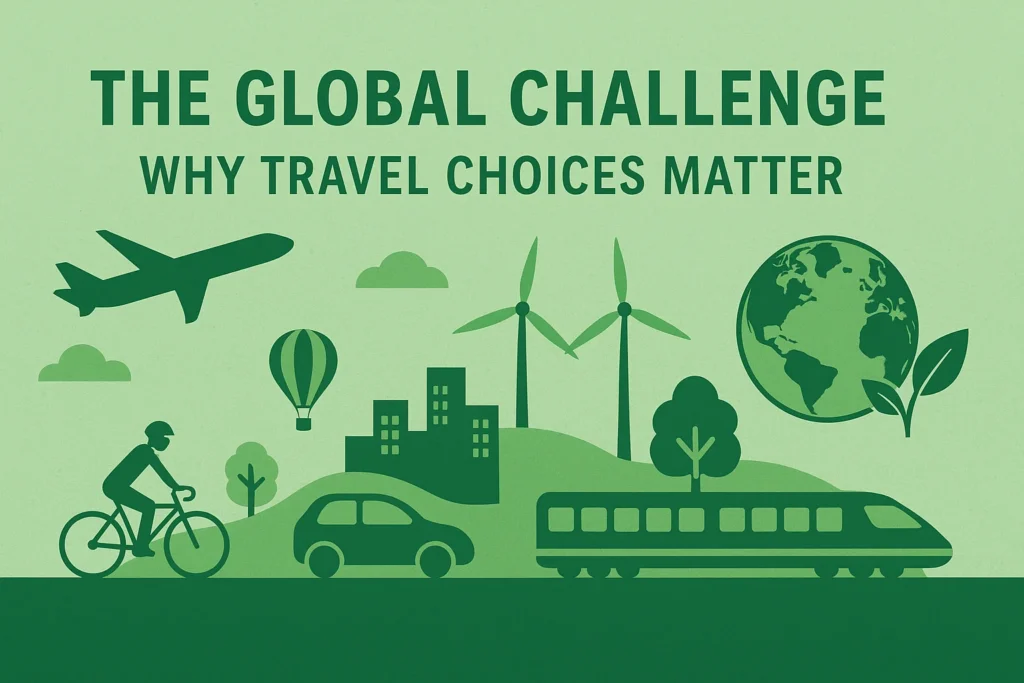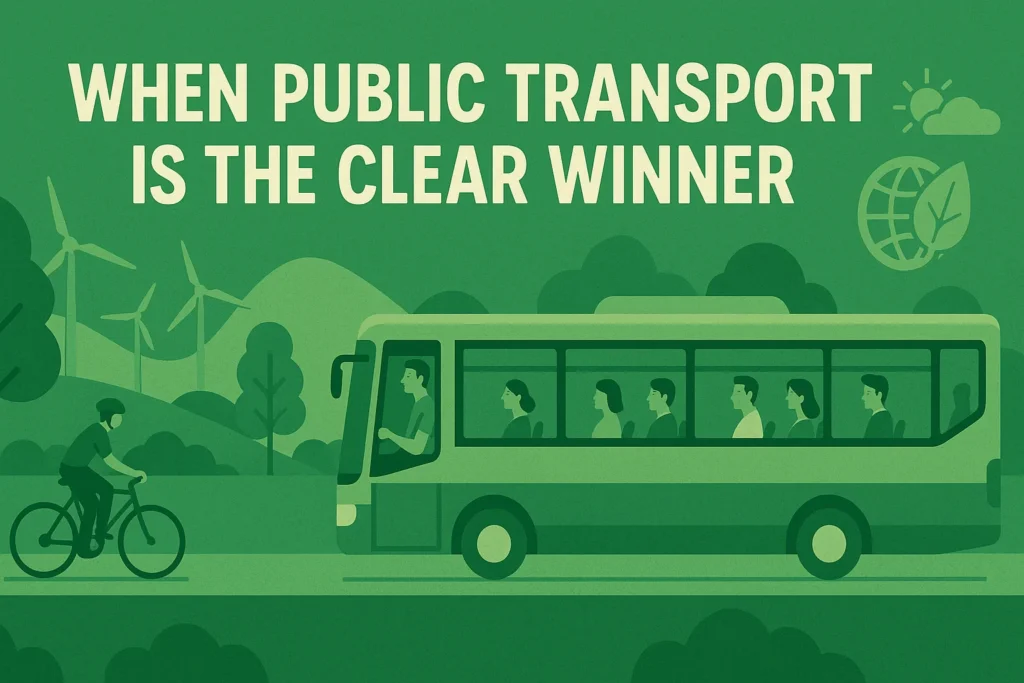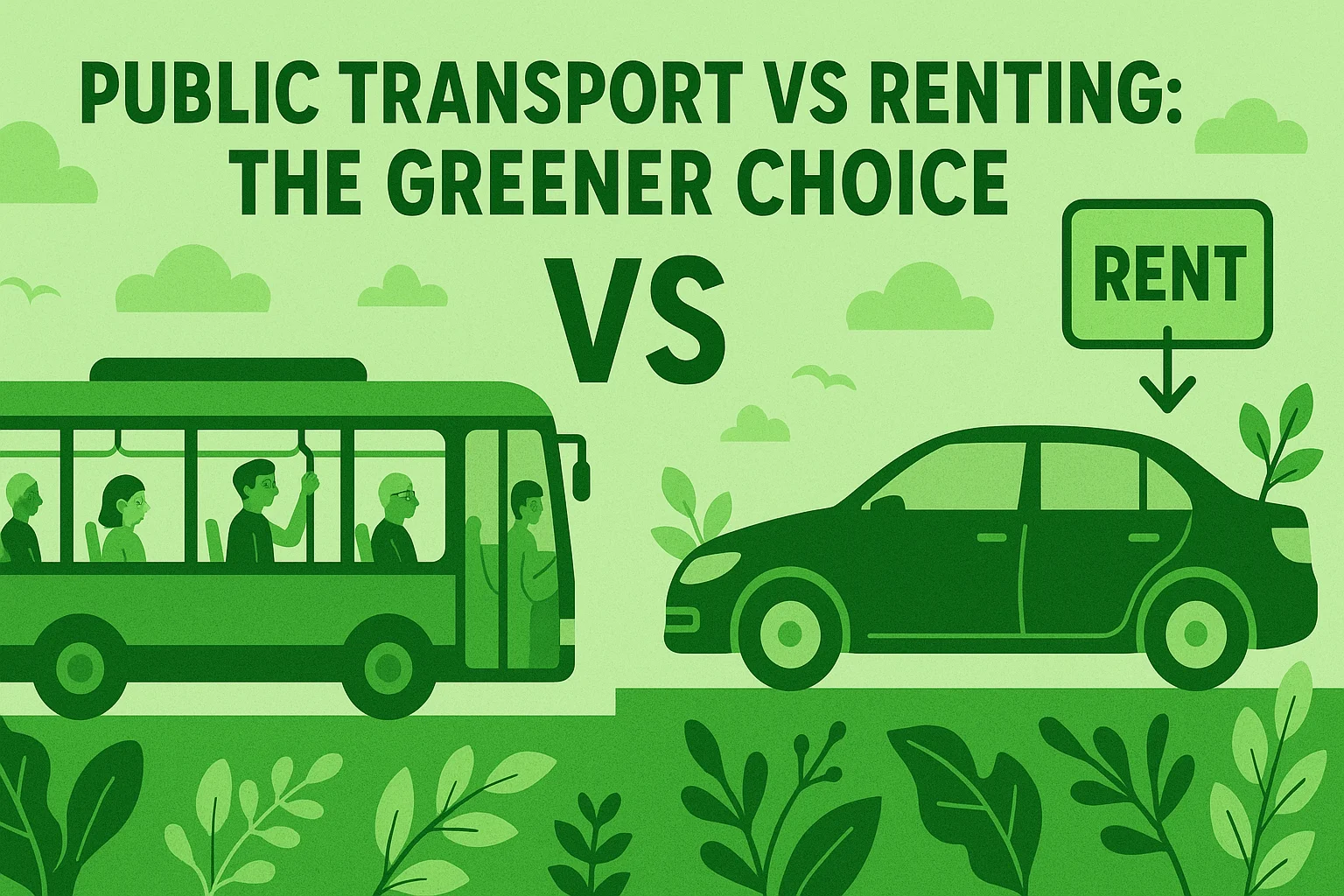Agree: Everyone wants to travel smarter — saving money, time, and the planet.
Promise: This blog isn’t just another generic debate. We’ll dig into real data, case studies, and everyday traveler stories to reveal whether public transport or renting is truly the greener choice.
Preview: You’ll also discover hybrid strategies (like combining trains with electric rentals) that balance comfort, cost, and carbon savings.
At Eco Gear Guides, we believe eco-friendly travel doesn’t mean sacrificing freedom — it means making smarter choices.
The Global Challenge: Why Travel Choices Matter

Transportation is the second-largest source of greenhouse gas emissions worldwide, after energy production. But how you travel can make a massive difference:
- A train journey from Paris to Lyon emits 5kg CO₂ per passenger.
- A rental car (petrol) for the same trip emits around 95kg CO₂.
That’s a 19x difference — enough to power a small apartment for nearly two weeks.
This proves that the “public transport vs renting” debate isn’t trivial. It’s about reshaping the future of sustainable mobility.
Public Transport: The Collective Climate Saver
Public transport is the backbone of sustainable cities. Instead of hundreds of individual cars, one bus or train can carry thousands of people with a fraction of the emissions.
Environmental Benefits
- Shared Energy Cost: Moving 100 passengers with one train requires less fuel than 100 separate cars.
- Air Quality Boost: Fewer cars = fewer pollutants like nitrogen oxides, which harm public health.
- Urban Livability: Cities with robust transport (Tokyo, Zurich, Singapore) consistently rank higher in global livability indexes.
Traveler’s Experience Example
Anna, a student in Berlin, calculated her annual commute:
- By metro: 380 kg CO₂ per year.
- By renting a car: 1,800 kg CO₂ per year.
Switching to public transport cut her footprint by 80% — the equivalent of planting 80 trees annually.
Renting: Freedom with Responsibility
Renting is often viewed as the less green option, but it has its place — especially when paired with eco-friendly rental innovations.
Modern Rental Trends
- EV Rentals Growing: Companies like Hertz and Sixt now dedicate 30–40% of fleets to EVs in major cities.
- Green Incentives: Some agencies give discounts for hybrid rentals.
- E-bikes and Scooters: Short-term rentals now extend beyond cars.
Case Example: Iceland
Public transport is limited outside Reykjavik. Tourists often rent cars to see glaciers and volcanoes. But by choosing a hybrid or EV rental, emissions are reduced by nearly 50%, while still enjoying full flexibility.
Read More : Packing Light and Green: Tips for Eco-Conscious Travelers
Smart Comparison: Beyond Just CO₂
| Factor | Public Transport | Renting a Vehicle (Fuel) | Renting (Electric/Hybrid) |
|---|---|---|---|
| CO₂ Emissions | Lowest (up to 90% reduction) | High | Medium to Low |
| Cost | Affordable, especially for solo travelers | Higher (fuel + insurance + parking) | Moderate (slightly higher rent fee) |
| Convenience | Route & schedule dependent | Maximum freedom | High (charging stations needed) |
| Cultural Experience | Immersive (local interactions) | Limited | Limited |
| Eco Score | ⭐⭐⭐⭐⭐ | ⭐⭐ | ⭐⭐⭐⭐ |
When Public Transport Is the Clear Winner

- Dense Cities: New York, Tokyo, Karachi — where car traffic is chaotic.
- Daily Commuting: Fixed schedules and shorter distances make PT unbeatable.
- Eco-Conscious Solo Travelers: Saves money and lowers emissions.
When Renting Becomes the Green Option
- Remote Travel: National parks, rural villages, deserts.
- Group Trips: One 7-seater hybrid is greener than three small cars.
- Electric Road Trips: Norway, Netherlands, and California already have charging networks that make EV rentals practical.
A Hybrid Model: The Future of Travel
Instead of choosing either-or, sustainable travel lies in mixing both smartly.
Example Travel Plan
- Paris → Lyon by Train (low emissions).
- Lyon → Countryside via EV Rental (flexibility for remote access).
This model reduces emissions by over 70% compared to full car rental.
Eco Gear Guides’ Advice for Travelers
At Eco Gear Guides, we recommend:
- Always check for EV rentals first — they’re growing fast worldwide.
- Use public transport in urban hubs to save time, money, and emissions.
- Plan hybrid trips: major routes by train, last-mile by rental.
- Offset your carbon footprint by supporting reforestation projects.
Conclusion
So, which is the greener choice — public transport or renting?
- Public transport is the winner in cities and commuting.
- Renting becomes green when it’s electric, hybrid, or shared among groups.
- The smartest travelers use a hybrid approach, blending trains, buses, and eco-friendly rentals to balance sustainability with freedom.
Traveling green doesn’t mean giving up comfort — it means choosing wisely, one journey at a time.
Read More : Travel Backpacks Made from Recycled Materials
FAQs
1. Is public transport always greener than renting?
Yes, in cities. But eco rentals can match PT in remote areas.
2. What about time savings?
Renting saves time in rural travel. In cities, PT often beats cars stuck in traffic.
3. Can I really find EV rentals easily?
Yes. Europe, North America, and parts of Asia now have EV fleets widely available.
4. Which is cheaper long-term?
Public transport wins for daily use. Rentals make sense only for groups or special trips.
5. How do I balance convenience with eco-friendliness?
Mix both: trains/buses for the bulk of travel, EV rentals for the flexible parts.


